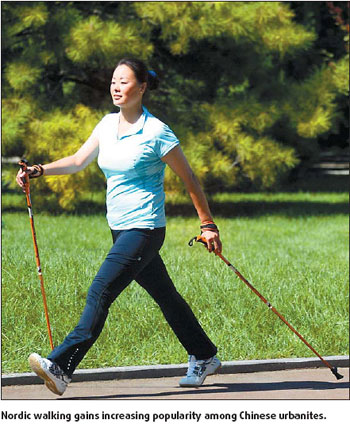In pole position
A group of more than 20 people lined up for a hike in the Summer Palace on Sunday morning, clutching poles that passers-by could easily have mistaken for skiing stocks.
"It may look odd, but it is an interesting form of exercise that demands skill," says Li Xiong, in his 50s, who stepped ahead of others.

Pushing the pole as far back as possible and keeping your arms and grip relaxed are key elements of a proper technique.
Called Nordic walking, or pole walking, the sport is becoming an exercise trend in major parks around Beijing. About 10,000 people don their long walking sticks at least once a week.
Nordic walking comes from Finland, where in the 1930s, cross-country skiers began using poles to stay in shape during summer. In 1997, a Finnish sports equipment manufacturer, together with sports medicine researchers and fitness professionals, developed it into a sport for ordinary people.
In Finland, more than 16 percent of the population participates in Nordic walking. Now, the sport has spread to about 40 countries, and in 2003, the China Institute of Sports Science of the General Administration of Sports introduced it to China.
According to the Nordic Walking Promotion Center of the institute, researchers have shown that Nordic walkers can burn 40 percent more calories and reach a heart rate five to 17 beats per minute higher than regular walkers.
It can relieve pain and muscle tension in the neck and shoulders, and also ease the symptoms of many chronic diseases.
Diagnosed with diabetes three years ago, Li often exercised by regular walking as advised by his doctors. However, he found it very boring. One year ago, walking with poles began to pique his interest.
"It is more challenging compared to normal walking. Walking more gracefully and faster requires technique and a lot of training. I enjoy the process of improvement," Li says.
The health benefits of Nordic walking were evident. He felt his stamina improve and his blood sugar level returned to normal.
According to Li, the majority of people starting Nordic walking are retirees like him, who have plenty of free time. Sometimes, they might walk long distances in the suburbs or even climb mountains.
Wen Xing, in her 40s and working in a bank, could only find the time to exercise on the weekends.
Nordic walking, in her eyes, was a way of exercising all of the muscles, including shoulders, arms and wrists. Also, the poles helped reduce stress in her knees and other joints.

Not just confined in the park, Wang Juanjuan, 52, an institution doctor, also takes the poles to the office. During breaks, she would walk for a few minutes.
Wang hopes she can influence more people to take up the exercise form. "Urban people rarely walk nowadays. They drive to the office, take the elevator and sit down all day long," she says.
Having no time for exercise is a common excuse for most people, according to Wang.
As a result of this, a growing number of people are developing high blood fat, high blood sugar and high blood pressure in the annual health checkups she organizes.
"This can all be reversed as long as you keep walking," she says.
(China Daily 10/31/2007 page19)














